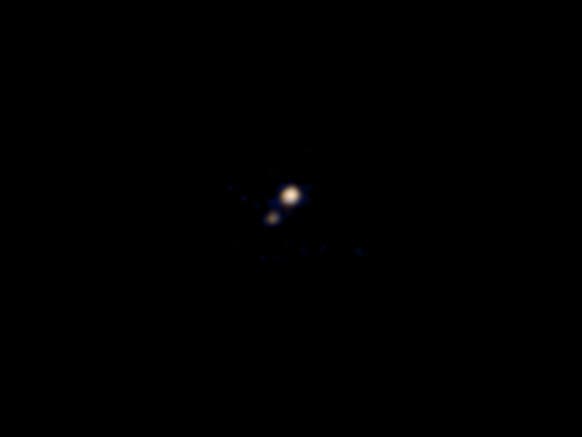These two dim dots are none other than Pluto, the dwarf plant, and Charon, its largest moon. Though it might not look like much, this is the first ever colored photograph of the two cosmic bodies ever taken. We have NASA’s New Horizons spacecraft to thank for this, which used its Ralph color imager to make the shot from 71 million miles away.

Even though this is very exciting, soon enough we’ll be treated to some very impressive photos as the probe gets closer and closer to Pluto, eventually making a flyby on July 17. In the meantime, NASA will release some more photos from the epic journey, as we’ve become used to (thank you, NASA!). Of course, New Horizon won’t stop there. After Pluto, it will delve into the Kuiper Belt – a region of space filled with trillions of icy bodies, remnants of the early solar system – and beyond.
“It sounds like science fiction but it is not,” said Alan Stern, the mission’s principal investigator, Agence France-Presse reported.
“Three months from today, NASA’s New Horizons spacecraft will make the first exploration of the Pluto system, the Kuiper Belt and the farthest shore of exploration ever reached by humankind,” Stern said.
The 1,000 pound spacecraft was launched nine years ago from Earth and has since made its way through most of the inner solar system, at a pace of about a million miles a day. This makes it the fastest spacecraft ever launched, powered by a plutonium nuclear reactor.
Charon, Pluto’s largest moon, is about the size of Texas. Some papers were published suggesting that the moon might have a thin atmosphere or even a frozen ocean, so it will be very exciting to see what it holds on its surface once New Horizon creeps near.
“There’s no doubt, Charon is a rising star in terms of scientific interest, and we can’t wait to reveal it in detail in July,” said Leslie Young, deputy project scientist, NASA reported.

Previously, New Horizon took some of the most outstanding photos of planets like Neptune or Jupiter, and moons like Io or Europa. The scientific and artistic contribution of the probe is thus invaluable.
“This is pure exploration. We’re going to turn points of light into a planet and a system of moons before your eyes!” Stern said, according to a NASA report.
“Nothing like this has been done in a quarter century and nothing like this is planned by any space agency ever again,” he said.






